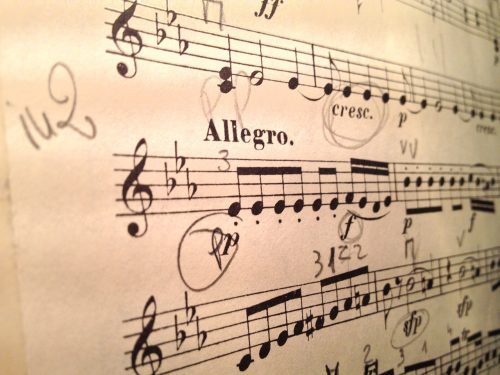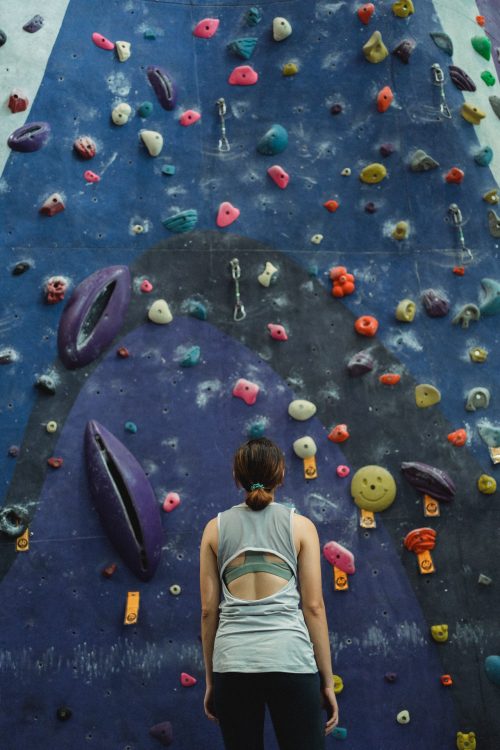This content was published: February 14, 2022. Phone numbers, email addresses, and other information may have changed.
Warm Demander Pedagogy
Posted by Greg Kaminski | 14 comments

My voice quavered as I responded to Dr. Barr, my freshman class music theory professor. “Eh? You’d like me to sight-sing this line of notes in front of my classmates? As in Do-Re-Mi…?” I had never even heard of “solfege” before, at least nothing beyond “Doe, a deer…” popularized by Julie Andrews in The Sound of Music. Dr. Barr, was not a warm and fuzzy fellow, quite the opposite of Maria, perhaps more like Captain Von Trapp. Clearly, running out of the classroom was not an option for me, nor was taking a pass, but somehow he earned my trust to lead me through that vulnerable moment without intimidation, and I grew to love his class.

Image licensed CC-BY-SA 3.0 David Kennard
“Why do you approach this research with such hesitancy? Such timidness?” Such were the words of my 400-level botany professor, Dr. Meese, spoken in a moment of frustration to the whole class in his thick German accent. The Reproductive Biology of Flowers was truly a fascinating course, and I gradually found myself following the lead of Dr. Meese, diving into close-up UV photography of irises scattered around the University of Washington campus, deeply intrigued that those fat furry bumblebees could visualize those attractive runways in ways that eluded my human sight.
These are among the professors I remember when asked to think of an educator who inspired a leap to a new level, someone who broadened my capacity for growth in an area I barely knew existed. Who are the educators who inspired you to new heights?
I think of Dr. Barr and Dr. Meese as “warm demanders” in a sense. Though not warm and fuzzy, they were not without compassion. Had I known what they were doing, I would have realized they were not trying to be rigid and inflexible. In their own way, they were showing compassion while at the same time providing an opportunity for me to engage in productive struggle, a necessary path toward moving from a dependent learner to an independent learner.
Leaning into productive struggle
Michelle Pacansky-Brock defines warm demander pedagogy as a culturally responsive teaching approach that creates opportunities for students to engage in productive struggle through engaging in challenging tasks, and this helps students develop from dependent into independent learners. She goes on to assert that all humans begin as dependent learners, and students who are poor and people of color are less likely to have had the privilege to be challenged in their educational experiences through productive struggle, which means they are more likely to be dependent learners.

Photo by Julia Larson, Pexels
It is precisely the productive struggle I experienced in the aforementioned classes that allowed me to engage and challenge myself, and struggle, but this is not the first step. Warm demander pedagogy and creating those opportunities for “productive struggle” is rooted in a strategy Pacansky-Brock refers to as “care and push.” The foundation for this is the building of trust in the instructor-student relationship. As Pacansky-Brock explains, “once a student knows you care about them and that you believe in them, they lean in. They challenge themselves. That’s when a student can flourish and reach their full intellectual potential.” I’m personally drawn to this image that a student will “lean in” and accept more challenge after gaining trust in the instructor.
Among the key characteristics of warm demander pedagogy is the need to express concern for students, not through passive sympathy, but by demanding a high quality of academic work. One of the main concerns we often have about showing compassion and some flexibility with our students in terms of deadlines, for example, is the fear that our expectations will diminish, that our courses will become less rigorous. Yet one of the pillars of the warm demander approach is that we challenge our students, all students, that we give them the opportunities for productive struggle essential in the path to become independent learners. Denying some students of this challenge denies them an opportunity for growth.
In discussing culturally relevant pedagogy, Gloria Ladson-Billings puts it this way…

Photo by Cottonbro, Pexels
“Culturally relevant teachers envision their students as being filled with possibilities. They imagine that somewhere in the classroom is the next Nobel laureate (a Toni Morrison), the next neurosurgeon (a Benjamin Carson), or the next pioneer for social justice (a Fannie Lou Hamer). The perspective moves the teachers from a position of sympathy (“you poor dear”) to one of informed empathy. This informed empathy requires the teacher to feel with the students rather than feel for them. Feeling with the students builds a sense of solidarity between the teacher and the students but does not excuse students from working hard in pursuit of excellence.” (White Teachers/Diverse Classrooms, p. 31)
The last phrase of that quote is the most revealing for us as educators. Indeed, the key principles of warm demander pedagogy used to develop intellectual abilities in dependent learners through cognitive struggle are perhaps best summarized by Pacansky-Brock in this intricate flow of “care and push.” A warm demander…
- Expresses personal warmth vs. impersonal professionalism
- Prioritizes building rapport and trust
- Clearly communicates high standards and scaffolds learning
- Shows personal regard for students
- Earns the right to demand engagement and effort
- Encourages and celebrates productive struggle
What about rigor?
What does this mean in terms of course rigor? Indeed, showing informed empathy, personal warmth, and compassion should not be equated with lowering our standards or less rigor. The warm demander approach starts with trust, proceeds with building the relationship, and at that point students will more readily engage with the challenge.

Photo by Allan Mas, Pexels
Thinking back to my own situation, what was it about the teaching of my professors, Dr. Barr and Dr. Meese that allowed me, actually inspired me to “lean in,” to accept the challenge, and to do so with passion, not only because a grade was at stake? What inspires you to “lean in?”
In my attempts to apply these strategies to my own teaching, I have not found the perfect balance of compassion, trust, relationship building and flexibility that always leads to student engagement. I think this pathway to engagement and the readiness to lean into productive struggle is highly individualized. A viable approach is to design what we think could be the most effective path toward this goal, but then be keenly aware of where our students are at, focus on trust, relationship building, and engagement, and then be prepared to to make small adjustments along the way.
Our students may not be ready to climb every mountain, but they will be leaning in more often to productive struggle along the path toward becoming independent learners. If there are warm demander strategies that have worked for you, please share!
Acknowledgement
Many of the ideas shared in this are based on the research of Michelle Pacansky-Brock, Faculty Mentor for the California Community Colleges CVC-OEI/@ONE. Michelle’s work focuses largely on humanized online instruction, and you’ll find a link to her full workshop presentation below. (If you can find the time, focus on the first 45 minutes.)
Resources for Further Exploration
- Being a Warm Demander: Challenging Students with Relationship-Rich Teaching and Wise Feedback, Michelle Pacansky-Brock, from the series “Fall Into Humanized Online Teaching: A Pathway to Equity, Fall 2021 (slides)
- Care and Push: Building Relationships with Students, Marcee Harris, The Chalk Blog, Mar 30, 2018.
- Student Centered Policies, Krysti Ryan, Kathryn Boucher, Christine Logel, & Mary Murphy, College Transition Collaborative, (See the final FAQ section Do student centered policies sacrifice rigor?)
- White Teachers/Diverse Classrooms, A Guide to Building Inclusive Schools, Promoting High Expectations, and Eliminating Racism, Chance Lewis and Julie Landsman, editors, 2006.

Comments
There are 14 comment for this article. If you see something that doesn't belong, please click the x and report it.
Add to the discussion
PCC offers this limited open forum as an extension of the respectful, well-reasoned discourse we expect in our classroom discussions. As such, we welcome all viewpoints, but monitor comments to be sure they stick to the topic and contribute to the conversation. We will remove them if they contain or link to abusive material, personal attacks, profanity, off-topic items, or spam. This is the same behavior we require in our hallways and classrooms. Our online spaces are no different.

Hi Greg: Thanks for this really thoughtful post. When you described your experiences with Dr. Barr and Dr. Meese, I immediately thought of “amygdala hijack,” where the “fight or flight” response kicks in. Zaretta Hammond wrote (on page 40 of her book CRT and the Brain): “When the amygdala sounds its alarm with cortisol, all other cognitive functions such as learning, problem solving, and creating thinking stop.” Yet you were somehow able to perform in the moment – you didn’t run away and you were challenged to do better and you did learn from the experience. What fascinates me is why some learners respond in the way you did and why others flee. My sense of many “dependent learners” (Hammond uses that phrase also) is that they often lack the resources to stand up to the challenge of a Dr. Barr or Dr. Meese and will indeed flee. I hear from many instructors that there is also a generational difference, and very few 18-year-old students will respond positively to such direct challenges. It makes me wonder if a trust-building phase is needed before an instructor can challenge a student to stretch a bit. I’ll be interested in seeing if others comment and share their experiences of demanding more of students. Thanks.
This is a terrific addition, Peter, and I appreciate the comment. I remember Zaretta Hammond discussing the “amygdala hijack,” and it definitely fits the episode I described with Dr. Barr. I’m sure that my performance of the task that day was mediocre at best, but I believe there was something about Dr. Barr’s feedback that allowed all students to gradually lean in. It was completely without judgement, so we all eventually felt comfortable in the vulnerable situation of sharing our voice. Indeed, I think it was part of the “trust-building phase” you described, a crucial phase before students will lean in and accept the challenge . Thanks.
Thanks so much Greg!
I agree with this whole approach, and with everything you discuss in your piece, Greg. In addition, though, I feel like when theory hits real life classroom … that’s when things sort of shake and threaten to fall apart. For example, some learners kick and scream given the opportunity to learn. I’m not sure why. I’m not particularly inclined to do it myself, but I do think it has something to do with past trauma. They’re fighting past ghosts that don’t really exist in the present learning environment. Also, if you provide an open window or unlocked door — some students will flee when things get hard. A bathroom break looks very appealing all of the sudden to them. I’m not sure about empathy at that point. I get determined and angry and stay vigilant — because if I don’t, the student will slip through the learning opportunity. Also, some students have become so focused on the grade, they’re not at all interested in learning. Cynical and short-sighted sometimes, students don’t want to be challenged. They imagine that upon getting to their desired program that they will miraculously not need the skills we’re trying to teach them. Of course, there are always students who thrive when challenged.
Thank you Greg, for this thoughful post. I am interested in hearing examples of how the characteristics of a warm demander are applied in the online classroom, specifically, how does one express personal warmth vs. impersonal professionalism,
prioritize building rapport and trust, and earn the right to demand engagement and effort?
Wonderful read!
Thanks for insightful comment, Bryan. Yes, the situation sounds familiar, and success is often elusive. Persistence in reaching out to students sometimes works. I sometimes feel that I’m being quite bothersome, though in a positive way, and I think it makes a student feel valued. I do get frustrated about spending 80% of my time with 20% of the students, but sometimes that’s what it takes. Perhaps you already use some sort of “getting to know you” survey at the start of the course. It can be helpful to ask students how they are feeling about the class right at the beginning. It can be helpful to send video feedback to a student who shares anxiety or insecurity about the class. I sometimes try to include more video feedback to students who might benefit from a more personalized approach, though to all students at least once during the term. I also like to schedule a required but brief 1-1 meeting with all students during the first few weeks to help build a connection and trust, but there’s no magic potion.
I’m glad you brought up the student focus on grades. Those of you who attended the Anderson Conference session on equitable grading might remember this research quote, “If a paper is returned with both a grade and a comment, many students will pay attention to the grade and ignore the comment. Comments have the best chance of being read as descriptive if they are not accompanied by a grade.” (Brookhart, How to Give Effective Feedback to Your Students, 2017) This is material for another blog, but have you considered “Ungrading?” I haven’t tried it, but I plan to give it a closer look, possibly for fall term. (If you’re curious, take a look at https://www.jessestommel.com/how-to-ungrade/.)
I too enjoyed this, especially because I bristle at the phrase “warm demander” even though, in practice, rigor and compassion matter deeply to me. I think my issue is with the “how” we get them to feel safe enough to be less passive, more internally motivated, and to trust themselves. I worry that if I appear to be “too” concerned in their success or failure as students (not in them as people, just the performance part) that I am reinforcing the sense that they are doing school to please the teacher, their parents, or the world, and my goal is always to access a bit their feisty self empowered nature–the part of them that wants the learning “in spite” of the challenges.
Thanks for these great questions, Alyson. Clearly, we could dedicate additional blog posts to this topic, and I hope others will continue the discussion, sharing thoughts and strategies that have worked. To start us off, here are a couple of ideas that come to mind…
When I think of expressing personal warmth, using video will help with this, e.g. for a welcoming instructor introduction or occasionally for feedback. Just so everyone is aware, in addition to using tools with D2L Brightspace for video/audio, PCC also owns a license for VoiceThread, which can be used in place of a few of the text based discussions. Providing helpful information about our class through the “Course Details” page along with links to a brief welcome video and a syllabus or even an introductory part of the syllabus can help build rapport and trust. Showing some degree of flexibility in the syllabus for life’s events can be helpful, or at least to rethink the use of rigid statements such as “No make-up exams or late work accepted.”
I’ll close this by offering another potentially useful resource. “Warm, Wise Feedback that supports High Standards + Effort + Ability + Specific Action” is a guide for giving feedback that is designed to inspire a growth mindset, https://bit.ly/3JBBQGr. This one focuses on a math course as an example, but it can be adapted for any discipline. (Created by the California Education Learning Lab under a CC-BY-NC license.) I look forward to hearing from others about strategies that have worked!
A very insightful post, Greg, thank you. It came at the perfect time for me when dealing with the challenges and frustrations of students not maintaining academic integrity during self-proctored midterm exams. This warm demander approach is very common for me at the beginning of the term, and then the monotony of the term (grading, grading, grading) sometimes kicks me into survival mode. This was a great reminder of our empowering role as educators.
As I read your insightful comment, Wendy, contract grading came to mind, and I wonder if you’ve tried it. I know that a number of composition instructors have used it as a way to engage their students in a more intrinsically motivated way, a strategy meant to empower students. I imagine if contract grading were combined with an increase in choice of ways to achieve the learning outcomes, it could lead to an increase in intrinsic motivation. I have used contract grading with mixed results, and I plan to try it again with adjustments. There are a few strong proponents of this method within the English SAC, and I could help you get in touch if interested. Here are a couple of resources:
I Have Seen the Glories of the Grading Contract…, John Warner, https://www.insidehighered.com/blogs/just-visiting/i-have-seen-glories-grading-contract
So Your Instructor is Using Contract Grading…Dan Melzer, D.J. Quinn, Lisa Sperber, Sarah Faye, https://writingcommons.org/article/so-your-instructor-is-using-contract-grading/
Hi everyone!
This is an interesting conversation.
The question that came to my mind as I finished reading this wonderful article was: Did Drs. Bar and Meese have training on this technique or did it happen organically for them?
I think that the amygdala would initiate the flight response for many students, perhaps the majority of them. This would be a great area to research. Does anyone know about any data on this?
I am afraid that the intent is well meaning but the impact may not be for many students.
There is a fine line between demanding warmly/pushing and caring and moving students to perform and be vulnerable, without causing a student freeze, have a panic attack or flee. The approach does matter. Maybe approaching and encouraging in private? Giving a student a “heads up” that this might be coming?
Good materials to ponder.
Great discussion, everyone!
Austina … this post for me also came at just the right time.
And Wendy, your comments also came at just the right moment. I agree with you that I have to be careful about what cultural norms (and whose norms they are) that I am asking them to adhere to or uphold.
Greg, I attended at NCORE last year a session on equitable grading. The guy who ran it rubbed me the wrong way as a person, but his ideas were quite good. And I’ve intuitively gone in that direction over the years … although not entirely. It’s more like a slow movement in the ocean.
Thanks for the post, Austina. I realize that maintaining academic integrity can be a hard nut to crack. It’s a slowly evolving process tied to trust, connection, and the development of intrinsic motivation.
Though it does remind me of being careful of how we phrase things in our syllabus, that some messages can promote a fixed mindset. Carol Dweck offers examples of such statements in her book Mindset: The Psychology of Success, 2016, e.g. “Your exams will all be multiple-choice and you will be observed with an online proctoring tool to ensure you don’t cheat.” We can compare this with statements designed to promote a growth mindset, e.g. “If you don’t earn a complete on all rubric criteria, re-do your assignment, and resubmit it for credit.”
These are great questions, Magda. Thank you for joining the conversation! I don’t know what type of training Drs. Barr and Meese had regarding this technique. I’m guessing that it happened organically for them. I do remember that Dr. Barr was accustomed to making himself vulnerable every day, at least so it appeared to me through his guidance by demonstration. I do not mean to be unkind by saying that his voice was perfect in terms of pitch, but not noteworthy in other ways. He modeled in such a way that there was no judgement in his class, and we were all able to lean in to that vulnerability. To me, it was frightening at the start. To him, it was probably not much more unusual than breathing.
Yes, it would be interesting to see some research about the amygdala and the flight response. There must be some out there, and perhaps some of our psychology instructors have delved into this area. I agree about the fine line in the steps between care and push, avoiding the result of having a student freeze. Personally, I like having “pass” as an option, or at least accepting performance of the task at whatever level the student is able to do at the time. In my case with Dr. Barr, for example, it would mean allowing us to sing one measure instead of the whole line or set of lines. He actually might have done that, but I don’t remember.
Good idea about encouraging students through a private conversation or a heads-up that this will be coming. I’m guessing that our public speaking classes are set up that way with steps toward a major speech, though there are those impromptu speeches – Yikes! Well, it’s another situation many think of when amygdala response is mentioned ;-)